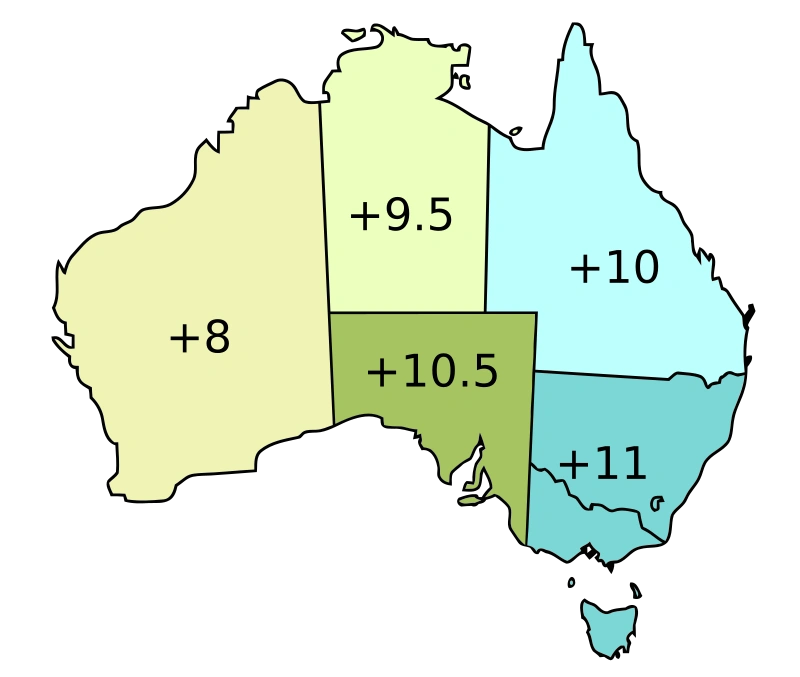The twice-yearly ritual of adjusting clocks divides Australia like few other issues. Half the nation participates. The other half refuses.
And the October 5, 2025 clock change is already stirring debate across homes, workplaces, and state parliaments.
For the 15 million Australians in New South Wales, Victoria, South Australia, Tasmania, and the Australian Capital Territory, clocks will jump forward one hour at 2am on Sunday, October 5, 2025, becoming 3am Australian Eastern Daylight Time.
That means one less hour of sleep. But it also means extended evening sunshine stretching well into spring and summer.
Queensland, Western Australia, and the Northern Territory? Business as usual. No clock changes. No confusion. And plenty of smug commentary.
The Clock Changes Explained
Daylight saving time moves clocks forward by one hour to 3 am, giving more daylight in the evening. The practice aims to make better use of natural daylight during warmer months.

Australian time zones during daylight-saving time
Here’s what happens:
October 5, 2025 (Start)
- Clocks move forward from 2am to 3am
- You lose one hour of sleep
- Evenings stay lighter longer
- Sydney’s sun will linger in the sky until close to 10pm by December 22, 2025 (the summer solstice)
April 6, 2026 (End)
- Clocks move back from 3am to 2am
- You gain one hour of sleep
- Sunrise and sunset happen one hour earlier, meaning brighter mornings but darker evenings
Most smartphones and computers adjust automatically. Analogue clocks, car dashboards, and microwaves require manual changes.
For analogue clocks, you’ll need to manually adjust the time. Setting your watch and household clocks before bed helps avoid timing issues.
Why Half of Australia Says No
Queensland, Western Australia, and the Northern Territory don’t observe daylight saving time. The reasons vary by state but share common themes.
Geography plays a major role. “The effect of DST becomes less as you move towards the equator, which is presumably why Queensland decided not to adopt daylight saving,” according to Professor Bedding.
Queensland’s decision came after a 1992 referendum was defeated with a 54.5% ‘no’ vote following a three-year trial from 1989 to 1992. The vote showed a stark divide between metropolitan Brisbane (which favoured it) and regional areas (which rejected it strongly).
Western Australia has rejected daylight saving in four separate referendums: 1975, 1984, 1992, and 2009, with voters returning a “no” vote of 54.57% in 2009.
For these states, the current system works. Sunlight already extends late into evenings naturally. Extra daylight during peak heat hours creates more problems than it solves.
During summer, Australia goes from three standard time zones to five time zones when southeastern states adopt daylight saving.
This creates scheduling headaches for businesses operating across state borders and confusion for travellers.
What Scientists Say About Health Impacts
Medical researchers have grown increasingly vocal about daylight saving’s health consequences.
Professional societies around the world with an interest in chronobiology, including the American Society of Sleep Medicine, the Society for Research on Biological Rhythms, and the European Society for Sleep Research, have consistently called to abolish daylight saving time.
The concerns focus on disruption to circadian rhythms – the body’s internal clock that regulates sleep, metabolism, and immune function.
Bright sunny mornings and low light evenings are important for promoting sleep. Daylight saving time disrupts this balance, leading to increased morning darkness and brighter evening light, delayed bedtimes and reduced sleep.
The economic cost is substantial. Sleep deprivation alone is estimated to cost approximately 2 per cent of a country’s GDP. For Queensland, this equates to an approximate loss of $9 billion per year.
Yet the debate rarely includes these health considerations in political discussions.
Australia’s minimum wage boost in 2025 shows government focus on living standards. But researchers argue that sleep quality deserves similar attention.
How to Adjust Your Body Clock
Changing your clocks can affect your sleep and daily routine. Here are research-backed strategies for easier adjustment:
Before the Change:
- Adjust your bedtime by 15 minutes each night before the change to help your body transition smoothly
- Set all non-automatic clocks before bed to avoid confusion
After the Change:
- Get outside in the morning to help reset your body clock
- Maintain consistent sleep schedules
- Avoid screens one hour before bedtime
- Skip the Sunday afternoon nap (tempting as it may be)
Children and pets often struggle more with the adjustment. Their internal clocks don’t understand policy decisions about daylight.
Gradual shifts over several days help ease the transition for families.

Clocks spring forward one hour at 2 am on October 5, 2025.
The Economic Arguments Both Ways
Supporters claim daylight saving brings economic benefits through extended shopping hours and outdoor recreation. The tourism sector particularly favours longer evenings.
Opponents point to costs: confusion, health impacts, and minimal energy savings in the modern era.
Daylight saving was originally introduced under the hopeful pretence of significant energy savings but this aspect has since been debunked as showing no real benefits.
Air conditioning use actually increases when hot evenings stay light longer. Modern LED lighting makes evening electricity consumption negligible compared to historical incandescent bulbs.
The debate continues without clear resolution. Each state makes its own decision based on local preferences.
History of Australian Daylight Saving
During World War I and World War II all states and territories had daylight saving by federal law, under the defence power in section 51 of the constitution.
The practice aimed to conserve coal and electricity during wartime. It was removed entirely in 1918 after World War I ended.
In 1967, Tasmania was the first state since the war to adopt daylight saving, prompted by a severe drought. The state has maintained it continuously ever since.
In 1971, New South Wales, Queensland, South Australia, Victoria, and the Australian Capital Territory also adopted daylight saving. Queensland pulled out the following year and has never permanently returned.
The dates have evolved too. Originally ending in late March, from the 2007-08 season onwards, DST in the south-eastern states and SA now starts on the first Sunday in October, finishing on the first Sunday in April.
Practical Impacts on Daily Life
The October long weekend coincides with the start of daylight saving in participating states. For those living in NSW, the ACT and South Australia, the change in time coincides with the October long weekend – the perfect time to explore a perfect weekend escape (remember this also means double demerits!)
Business operations face challenges. Conference calls between Sydney and Perth suddenly require three hours’ difference instead of two.
Flight schedules adjust. Train timetables change. Sports broadcasts shift by an hour for interstate viewers.
Banks and financial institutions must coordinate carefully. The Reserve Bank of Australia officially notes that local time is advanced one hour when daylight saving commences and put back one hour when it ceases.
International coordination adds another layer. While Australia springs forward in October, the Northern Hemisphere falls back, creating temporary scheduling chaos for global businesses.
Also Read: Australia Takes Aim at China’s Lithium Processing Empire—But Can It Win?
Looking Ahead
The daylight saving debate shows no signs of resolution. Strong opinions exist on both sides with valid arguments supporting each position.
For now, Australia maintains its patchwork approach. Half the nation springs forward. Half stays put.
October 5 approaches quickly. Check those clocks. Adjust your routines. And prepare for the annual tradition that divides the country like Vegemite or pineapple on pizza.
Recent changes in Australian regulations demonstrate how state-based decision making shapes daily life across the nation.
Whether daylight saving makes sense for your state depends largely on where you live, what you do, and how your body responds to disrupted sleep.
One thing’s certain: the alarm will still ring on Monday morning – even if it comes an hour earlier than your body expects.
FAQs
Q: Does all of Australia observe daylight saving?
A: No. Only NSW, Victoria, South Australia, Tasmania, and the ACT participate. Queensland, Western Australia, and the Northern Territory maintain standard time year-round.
Q: When do clocks change in 2025?
A:Forward: October 5, 2025 at 2am (clocks move to 3am). Back: April 6, 2026 at 3am (clocks return to 2am).
Q: Do smartphones automatically adjust?
A:Yes. Most modern devices with internet connections update automatically. Check settings to confirm your device is configured correctly.
Q: Can Queensland or WA ever return to daylight saving?
A: Possibly. Any change would require a referendum. Given multiple failed attempts, this seems unlikely in the near term.
Q: What’s the health impact of the clock change?
A: Research shows disruption to sleep patterns, increased cardiovascular events in the days following changes, and mood impacts. Effects vary by individual.












